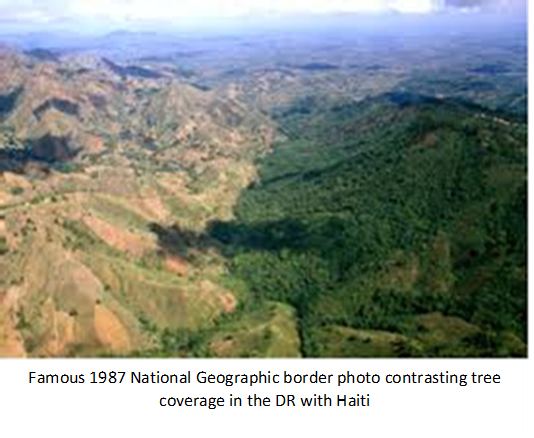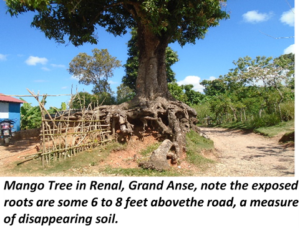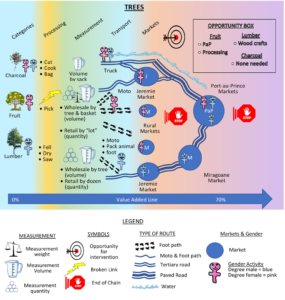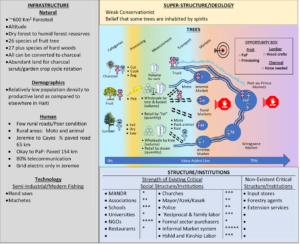Using the MEVMS value chain research and presentation strategy described here, this paper provides a rapid summary of the Fruit, Lumber, and Charcoal value chains in rural Haiti. The research is based on literature review, focus groups and a 405 household survey in the Grand Anse conducted in January 2018 on behalf of Heks-Eper. [Go here to see the Full Report and here for Value Chain Only Report and here to find the Focus Group Transcriptions and Translations.]
Fruit, Lumber & Charcoal Ethnographic Value Chains in Haiti

Overview of Trees in Haiti
Trees and deforestation are topics that greatly concern international conservationists and aid organizations. Haiti has reportedly gone from 30 percent forested in 1940 to 10 percent in 1970 to 2 percent at the turn of the millennium (Michel 2001). Beginning with the now famous 1987 National Geographic picture (see above or go here for more recent National Geographic photos and exposes on the topic), it has been common for researchers to site aerial photographs illustrating the radical difference between foliage on the Dominican Republic vs. the Haitian side of the border. Ignoring that these photos were taken in areas where the Dominican Republic has a well-guarded national park whereas, with onset of political turmoil in 1986, Haitian authorities abandoned this area of the border, there are some problems with the extremity to which Haiti has been presented as completely deforested. In 2014, Churches et al summed up the exaggeration when they compared Landsat Thematic Mapper (TM) imagery and, using international criteria for deforestation, determined that Haiti had about 30 percent forest cover, about the same as the United States, France, and Germany, and much higher rate than Ireland and England (see Churches et al, 2014).

Whatever the case, that much of Haiti suffers deforestation significantly more severe than in the past cannot be gainsaid. To know this one does not need scientific studies. One has only to look out the window of the plane when flying into Haiti to see the billowing underwater clouds of silt, topsoil washed down from the mountains. In those mountains, spectacular gully erosion and exposed tree roots serve as type of meter for the speed with which erosion has been occurring (see Photo left). In the valleys, houses that have almost disappeared under ground serve as barometers of erosion as well. Moreover, for the purposes of understanding how to help rural Haitians, trees are not only a check against erosion, they are a critical resource for peasants. Below, we have divided the topic into the categories of Fruit, Lumber and Charcoal.[i]
FRUIT
Types
There are at least 26 species of fruit tree in Haiti. Mangos are especially important. In 1990 Haiti was the 2nd largest importer of mangos to the US. Haiti still ranks 6th overall . Moreover, Haiti was only exporting one type of mango in significant quantities—the Francique. Only 20 percent of mangos in Haiti are Francique and only twenty percent of the Francique grown in Haiti are exported (see Schwartz 2015). Other major types of mango are fil, kòn, batis, kawòt, kakòn, laben, and, labich (see Mango Value Chain in Haiti). In Haiti, mangos and other fruit trees are best described not as a planted, cultivated and cared for perennials, but as a prolific and appreciated weeds, sprouting up from discarded seeds in moist ravines hillsides and slopes.
Primary Stakeholders
Owners. Market women.
Secondary Stakeholders
Pickers. Consumers.
Production
Fruit tree cultivation strategies are best characterized as opportunistic rather than deliberate or planned. Peasant cultivators in Haiti do not deliberately germinate, nurture and plant trees. They will nurture a seed that sprouts on its own. They may even dig up the sapling and move it to a preferred location. But the only nurseries that have existed in the region were all either associated with the state or, more commonly, an NGO. Nevertheless, farmers report wanting trees, particularly fruit trees and particularly mango, breadfruit, coconut and citrus trees. If given the seedlings, they will plant and nurture them.
Byproducts
Medicinal leaves, Charcoal, Lumber, Roofing thatch. Seeds
Technology
Farmers rarely use neither pesticide nor fertilizer on their fruit trees. Regarding the pruning of trees, farmers do not deliberately prune nor clean trees to allow greater sunlight and dispatch dead branches. Regarding material technology, most people in Haiti use only machetes and simple picking poles.
Main Work Organization Structure
Household organized work organization with some semi-professional pickers.
Most Significant Relationship inVvalue-chain
Land tenure/ownership of trees, kinship.
Sexual and Age Division of Labor
In the event the fruit is to be sold, it is women who will orchestrate the harvest, transport and sell the fruit. The actually picking of the fruit is the task of boys and men. Children will help with all the tasks. Boys are more likely to help pick, sort and transport fruit. Girls will sort and help their mother’s package, transport and sell the fruit.
Tenure
Trees on family land are owned and can be exploited by all the family, even extended relatives. The fruit from trees on hereditary land that has already been divided or on purchased land are thought of as the possession of the woman, but in the name of the household.
Financial underwriters
Aid agencies underwrite the costs of nurseries.
Source of financing
N/A
Hiring
Women may pay men to harvest a tree for her and she may pay for transport of the produce.
Sale
Drawing on focus group discussions, the bulk of fruit probably does not get sold but rather eaten by the owners, neighbors and friends. Coconuts and cashews are exceptions.
Measurement
Fruit is packaged and sold at the wholesale level in panye (basket) and then detailed in small piles (lo) of 3 to 4 fruits. However, market women sometimes buy entire trees, harvest them and haul the fruit to the market, town, or city for sale. In this sense fruit is sold wholesale by volume and retailed in quantity.
Package and Transport
To reach main roads, women carry the fruit by foot or pack animal or they pay moto-taxis. If they are destined for a city, upon reaching a/the main road they will use public taptaps, buses or truck. In the event that an entire tree is harvested, they may hire a small truck
Market Venue
Fruits are sometimes wholesaled at the tree to a single buyer who will harvest the entire tree. It is typically sold per basket at markets and ultimately detailed locally in front of homes, at crossroads, and in markets. However, most fruit will be either eaten or sold retail.
Consumers
In areas near to major cities, or near to paved roads, fruit is shipped to the city. But most fruit in rural Haiti consumed by people with access to the tree, sold locally to consumers or, as explained above, it will be sold wholesale in baskets to women who then detail the fruit in lo (piles of 3 to 4 pieces of fruit) to final consumers.
Afflictions
Diseases have reportedly increased in recent years. Farmers complain about “black soot”, something that is actually a byproduct of insect infestation (sugar excreted by the insects). White flies appear to be a significant part of the problem.
Opportunities
- Treating the insect problem.
- Nurseries, tree planting.
- Commercialization and/or processing of fruit into juices and preserves is an economic opportunity that could be promoted.
LUMBER
Types
There are no fewer than 27 major types of wood used as poles and/or sawed into boards. Some fruit trees become lumber. Mango is especially valued as lumber and prized for constructing dories. Breadfruit and avocado trees were mentioned in focus groups and the survey as a good source of lumber.
Primary Stakeholders
Owners, sawyers, transporters, wood vendors in markets.
Secondary Stakeholders
Carpenters. Homeowners, builders.
Production
Similar to fruit trees, strategies regarding the cultivation of wood trees are best characterized as opportunistic rather than deliberate or planned.
Byproducts
Medicinal leaves and charcoal.
Technology
Farmers use machetes to fell trees. They use long, dual-handled hand saws to make boards.
Sexual and Age Division of Labor
Cutting trees is, like picking fruit, an entirely male undertaking. However, unlike fruit which women sell, the marketing of lumber is a male undertaking, something unusual in that most marketing of local produce is dominated by women. Indeed, handling of cattle, lumber, and fishing might be the only three productive activities that can be characterized as exclusively male domains. Other male activities, such as planting gardens, are readily assumed by women. In the absence of men, women will even pick fruit and make charcoal.
Tenure
Lumber and wood trees are typically owned by men. A person can sell a living tree to another person. After sale the tree can remain standing on the original property several years.
Hiring
The actual cutting of trees and sawing them into lumber is considered a skilled occupation accomplished by paid craftsmen.
Main Work Organization Structure
Professional sawyers who work in 2-man teams.
Most Significant Relationship in value-chain
Land tenure/ownership of trees. Buyer and seller of trees. Buyer and sellers of boards.
Sale
Lumber is critical both for its uses and to sell in exchange for income. Campeche (logwood) and Grigri (rose wood) are used as posts and beams for houses. Mahogany, oak, cedar and at least a dozen other hardwoods are hand sawed into boards and used to make house walls, furniture, caskets or sent to provincial cities and Port-au-Prince for resale, providing an important source of household income.
Packaging and measurement
Poles and boards are sold by quantity (dozens), but with an appreciation for size and type.
Package and Transport
Boards and poles are carried by the owner, porters or pack animal to the nearest road and then loaded on moto taxi, bus or truck. They are sometimes, but rarely, shipped on boats.
Market Venue
Poles and lumber not sold in the rural areas are transported to towns and cities at lumber sections of markets or, very commonly, markets that are exclusively for lumber.
Consumers
Poles my be used by anyone but boards are best thought of a as a raw material to be processed by skilled craftsmen. The primary purchasers of wood are carpenters in home construction, or making furniture and caskets.
Afflictions
Diseases have reportedly increased in recent years. Farmers complain about “black soot”, something that is actually a byproduct of insect infestation (sugar excreted by the insects). White flies appear to be a significant part of the problem.
Opportunities
- Planting of lumber trees
- Preparation of lumber and sale as exotics woods
CHARCOAL
Types
The branches of trees cut for lumber or any tree felled by foul weather or otherwise, becomes fuel for local cooking and charcoal. Young Birdcherry , Lucena, and Acacia, as well as any other tree that farmers would prefer not to nurture, are harvested as saplings to make charcoal. While participants in focus groups insisted that they never cut a healthy fruit tree to make charcoal, any tree may become charcoal. Fruit trees that get old and do not yield will become both lumber and charcoal.
Primary Stakeholders
Owners of charcoal, transporters, vendors, buyers, consumers.
Secondary Stakeholders
N/A
Production
The branches or samplings are cut, cleaned of leaves, piled up with dry leaves interspersed among them, then covered with dirt and green leaves to make a type of stove, whereupon the inside of the pile is lit. The wood smolders for several days; half-burned throughout, it becomes charcoal.
As mentioned above, any old or fallen tree may be transformed into charcoal, but a major system of production is the harvesting of young trees on agricultural plots, something that fits into a 5 to 8-year fallowing cycle whereby farmers clear the land, make charcoal with the cut brush, then plant gardens with quick growing bean, melons, a variety of tubers, including yams and manioc. After the seasonal crops have been harvested, yams and manioc continue to grow for several years, their roots edible roots harvested as needed. Meanwhile, the garden is once again becoming a thicket of small trees. When the manioc and tubers have been harvested, the farmer eventually returns again to cut the saplings, make charcoal, and then plant a new garden.
Byproducts
Medicinal leaves
Technology
The entire process is accomplished with machetes.
Main Work Organization Structure
Household organized labor. Some professionals.
Most Significant Relationship in value-chain
Land tenure/ownership of trees. Transporters.
Sexual and Age Division of Labor
Men more than women clear gardens, pile the sticks, cover and fire the charcoal. Women and children play a more significant role in sorting the charcoal and putting it into sacks. The man will help his wife or female relative bag, move, and ship charcoal to the city for sale. Some men will accompany the charcoal to the city for sale. Retailing charcoal is, like most trade in local produce, a female activity.
Tenure
With the exception of those professional charcoal entrepreneurs mentioned above, women are typically thought of as the owners of any charcoal that is produced in the name of the household.
Hiring
Farmers often hire charcoal specialists, paying them a part of the harvest in exchange for helping them clear a garden and process the harvested sticks into charcoal. Some professional charcoal entrepreneurs will also buy uncut fields to process into charcoal for sale. And some farmers will simply sell the wood from a cleared field.
Sale
Charcoal is unquestionably one of the most important sources of income for farmers in area such as the Grand Anse. It is entirely a cash crop. Virtually all the charcoal produced is destined for sale in urban areas. Almost as a rule, rural farmers do not use charcoal for cooking fuel but rather wood. It is noteworthy that charcoal is a critical resource when crisis strikes, either regionally or in terms of household shocks. Households with no animals or mature trees to sell will turn to the production of charcoal during hard times. After Hurricane Matthew, the Department of the Grand Anse and Nippes benefitted from the enormous quantities of fallen trees and broken branches, a veritable economic boom in charcoal production, amounting to as much as $35 million in income for the Grand Anse along (estimate from Franck Saint Simon, HEKS EPER Chief of Party in 2016).
Packaging and measurement
Charcoal is sold in volume. Wholesale, it is packed into polyethylene sacks. The standard charcoal sack is actually two sacks sewed together lengthwise. A single double-sack may way as much as 150 lbs. Sacks are sold in lots of 10. Charcoal is retailed by the mamit (quart) or the lo (small pile).
Price
A lo (lot) of 10 sacks fetches $700 to $800 Haitian dollars (US$50 to $70). If transported to Port-au-Prince the increase can be 70 to 100% in value.
Transport
Charcoal is stacked by the roadside and picked up by large trucks that ply the rural roads. On the coasts it is loaded onto sailing vessels. A portion is destined for provincial cities but most is destined for the more lucrative Port-au-Prince market. Transport to Port-au-Prince from the most remote areas, such as the Grand Anse, was $25 Haitian dollars per sack (~US$2) in 2018.
Market Venue
Charcoal is sold to buyers from the city or hauled to the city by the owner on one of the many trucks engaged in the transport of charcoal and sold at charcoal depots, special areas where charcoal is traded in bulk.
Consumers
People in rural areas do not use charcoal as cooking fuel, rather they cook with wood. Charcoal is the primary cooking fuel in urban centers, far more common than propane gas.
Afflictions
None
Opportunities
- Improved methods from transforming wood into charcoal can reduce losses by as much as 40 percent.
- Making briquettes from dried leaves and sugar cane baggage
MEVMS Maps for Grand Anse
Below are a series of largely self-explanatory tree value chain and marketing maps produced using the MEVMS (Multidimensional Ethnographic Value Chain Mapping Strategy).


[i] There are laws in Haiti that govern and restrict the indiscriminate cutting of trees, but they are not enforced today nor would they be enforceable without inflicting economic hardship on the people living in the region. All over Haiti cutting trees to saw boards and make charcoal is a final recourse in the face of hard times, drought and starvation. This is particularly true in the Grand Anse where virtually everyone depends on wood for cooking fuel and virtually everyone depends on domestic production for lumber supplies.







